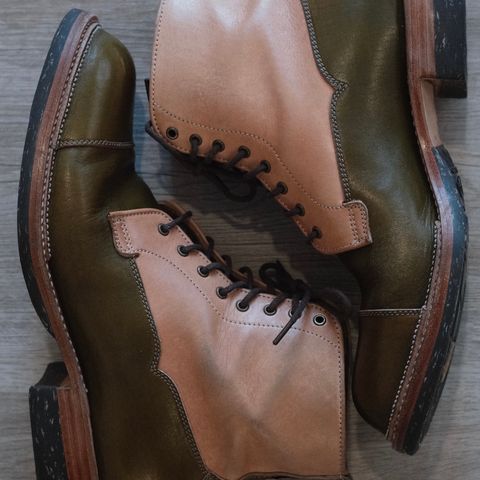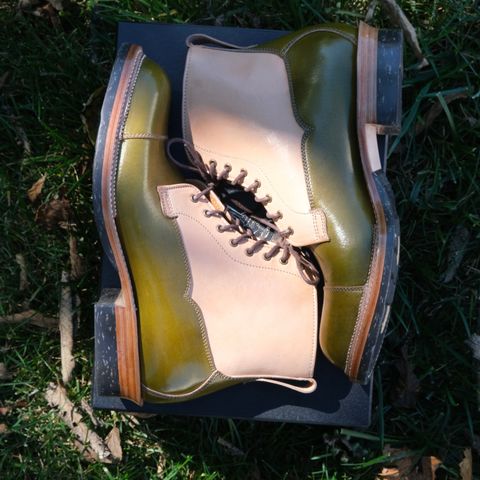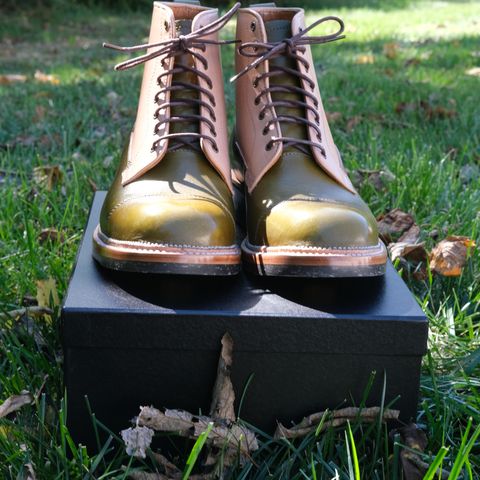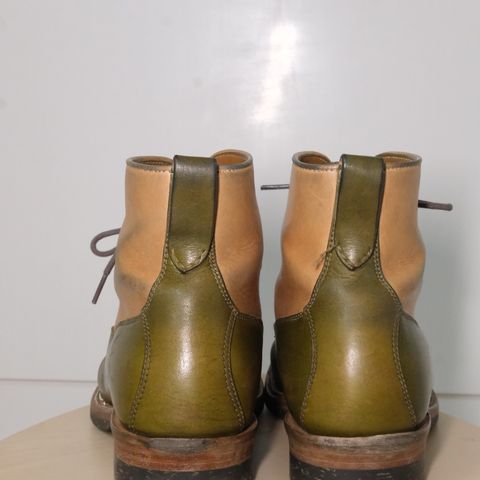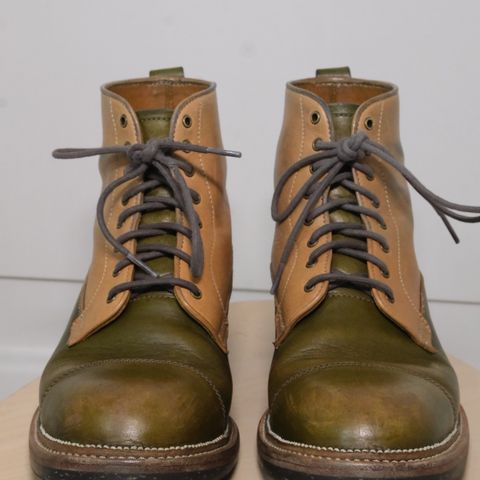Shinki Natural Horsehide Overdyed Olive
Leather Color • exclusive for MidasAbout
Shinki Natural Horsehide Overdyed Olive is an exclusive leather colorway produced by Shinki Hikaku Tannery in Japan for Midas Bootmaker of Indonesia. This latigo horsehide features natural vegetable-tanned horsehide overdyed with a removable olive pigment layer, creating a teacore effect where the outer olive layer gradually wears away to reveal the natural tan leather underneath. The leather combines Shinki's heavyweight horsehide characteristics with an overdying technique that produces distinctive patina development through wear.
About
Shinki Natural Horsehide Overdyed Olive is an exclusive leather colorway produced by Shinki Hikaku Tannery in Japan for Midas Bootmaker of Indonesia. This latigo horsehide features natural vegetable-tanned horsehide overdyed with a removable olive pigment layer, creating a teacore effect where the outer olive layer gradually wears away to reveal the natural tan leather underneath. The leather combines Shinki's heavyweight horsehide characteristics with an overdying technique that produces distinctive patina development through wear.
Shinki Hikaku specializes exclusively in horse leather production at their facility in Himeji City, Hyogo Prefecture, Japan. The tannery uses traditional vegetable tanning methods with natural air drying and aging stages that take up to four months to complete. This latigo horsehide receives additional treatment through an overdying process that applies a thin, removable olive-colored pigment layer to the natural vegetable-tanned surface.
Leather Production
Tanning Process
Shinki Hikaku sources horsehide from the loin area to the rump of horses, selecting hides for their characteristic light weight and suppleness. The tannery conducts tannin tanning carefully in pits, where hides cure for months in bark and water solutions. This vegetable tanning technique has been passed down through generations since the company's founding in 1951. The process produces a full-grain, uncorrected finish that preserves the natural grain and texture of the hide.
The tanning creates extra heavyweight horsehide with low initial flexibility. Shinki carefully controls the application of grease, chemicals, and paint based on the intended product design. The leather develops a beautiful polished luster with a less waxy feeling than some other horsehide treatments, while the dense grain provides durability and resistance to wear.
Overdyeing Technique
The natural overdyed process begins with fully vegetable-tanned horsehide in its natural tan color. Tanners then apply asportabile removable pigment in an olive shade to create what is known as teacore leather. The overdye layer remains thin enough that everyday wear yields patina development as the outer layer gradually chips or fades through use.
This technique represents a specific approach to creating dual-tone leather effects. Unlike permanently dyed leathers, the removable nature of the olive pigment allows the natural tan base to emerge progressively through wear, stretching, and handling. Wear points such as toe boxes, heel areas, and lace friction zones typically show color changes first as the outer layer breaks down.
Aging Characteristics
The teacore effect in this leather manifests as the outer olive layer slowly fades or chips away to reveal the rich brown inner layer developed during vegetable tanning. The aging process creates a dynamic appearance that shows the garment's or boot's history of use. Natural wear causes the leather to develop creasing and areas that darken from general exposure and sun contact.
Vegetable-tanned horsehide displays patina-worthy characteristics through the retention of grain and texture from the animal hide. The full-grain uncorrected finish means that shrunken grains emerge over time, particularly after getting wet, creating ripples that mold to the wearer and develop character. The combination of the teacore effect and natural vegetable-tanned aging creates a distinctive evolution pattern.
Exclusive Availability
Midas Bootmaker maintains this leather as an exclusive offering through their partnership with Shinki Hikaku. The Indonesian bootmaker sources leathers from renowned tanneries including Badalassi Carlo of Italy, Horween of the United States, and Shinki of Japan. Midas constructs boots using completely handwelted and handsewn methods with various construction types including flat welt, Norwegian storm welt, Veldtschoen, Stairschoen, and chainstitch.
The company designs their boots to withstand jungle and pavement conditions, reflecting their Indonesian origins and international market focus. Customers can order Midas boots through the brand's make-to-order program, which offers custom leather selections. The difficulty of procuring heavyweight horsehide from Shinki means availability can be limited, with some manufacturers reporting wait times of up to a year to secure allotments of specialized horsehide leathers.
References
"Service Boot Horsehide Latigo". Viberg. Retrieved October 11, 2025.
"About the Brand - Midas Bootmaker". House of Agin. Retrieved October 11, 2025.
"HORSE-HIDE". Shinki Hikaku. Retrieved October 11, 2025.
"Overdye Natural Camello by Tempesti Leather". Oak Street Bootmakers. Retrieved October 11, 2025.
